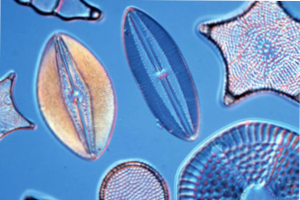One of the greatest challenges surrounding regime shifts is identifying them before they happen. In recent years there has been a variety of methods proposed for detecting early warning signals for regime shifts. Within this specialized field Craig Allen and colleagues have focused on patterns of discontinuity. In a recent paper Spanbauer et al, co-authored by Craig and several other RA members, they demonstrate how discontinuities over time in the body size of diatoms signaled a regime shift 150 years before it happened.
A regime shift implies crossing a threshold and changing how the system is structured and how it functions as well as how it maintains the new regime through system feedbacks. A well studied, climate-driven regime shift in Foy Lake in the northern Rocky Mountains made it possible for the authors to examine fossil diatoms spanning thousands of years to compare the size aggregations of diatoms with known stable periods in the history of the lake.
The authors found that size aggregations changed with the regime shift, suggesting that discontinuity analysis may provide a complementary method of detecting regime shifts that would potentially allow sufficient time to intervene and manage for resilience.
Paper link: http://rspb.royalsocietypublishing.org/content/283/1833/20160249
Citation:
Body size distributions signal a regime shift in a lake ecosystem
Trisha L. Spanbauer, Craig R. Allen, David G. Angeler, Tarsha Eason, Sherilyn C. Fritz, Ahjond S. Garmestani, Kirsty L. Nash, Jeffery R. Stone, Craig A. Stow, Shana M. Sundstrom
Proc. R. Soc. B 2016 283 20160249; DOI: 10.1098/rspb.2016.0249. Published 22 June 2016
Related research:
Spanbauer TL, Allen CR, Angeler DG, Eason T, Fritz SC, et al. (2014) Prolonged Instability Prior to a Regime Shift. PLoS ONE 9(10): e108936. doi:10.1371/journal.pone.0108936

Keywords: regime shift, discontinuity, diatoms